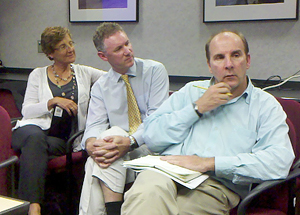Joining ICT4D To Learn About Using Technology For Agricultural Development
 On August 22, the ICT for Development (ICT4D) Learning Network hosted an expert panel on how ICTs, or information and communication technologies, are enabling agriculture and improving livelihoods worldwide. The event, held at the USAID Public Information Library, was co-organized by Appropriate IT and the USAID-funded FACET Project, which is being implemented by FHI 360. FACET works to enhance agricultural value chains and facilitate trade in agricultural products across Sub-Saharan Africa by providing technical assistance on the use of ICT tools to improve competitiveness and productivity.
On August 22, the ICT for Development (ICT4D) Learning Network hosted an expert panel on how ICTs, or information and communication technologies, are enabling agriculture and improving livelihoods worldwide. The event, held at the USAID Public Information Library, was co-organized by Appropriate IT and the USAID-funded FACET Project, which is being implemented by FHI 360. FACET works to enhance agricultural value chains and facilitate trade in agricultural products across Sub-Saharan Africa by providing technical assistance on the use of ICT tools to improve competitiveness and productivity.
The first presenter on the panel was Grahame Dixie, the Agribusiness Unit Team Leader for the World Bank’s Agriculture and Rural Development department. Dixie’s presentation covered a lot of the new research by IFPRI and others about how farmers and people in agriculture value chains are using ICT and what the effects are. Focusing mainly on telephones (both public land lines and private cell phones), he explained that there is good evidence that phones are raising rural income (Peru), improving commercial farmer income (Philippines), and leading to changes in cropping mixes and marketing methods (Morocco). That said, according to Dixie, the most important function that phones seem to serve is to connect players in the value chain in a way that promotes trust between them, leading to sharing of critical market intelligence.
In Grahame Dixie’s experience, a critical area where technology can play a big role is logistics. To illustrate this point, he told this story about women backyard poultry producers in Bangladesh:
“[The women] found out that the prices that they received for their chickens was less than half that of the prices in the nearest major market. They decided to contact the visiting trader and demand an explanation for paying so badly. The trader explained that he had to cover all his costs of getting to and back from their village over the few chickens they could sell him, and he could not afford to pay them more. How many chickens would he need to buy to be able to pay sensible prices? Fifty, he replied. They found that he has a cell phone and now actively seek out sufficient chickens to sell from an extended group, and call him in when they have aggregated a sensible critical mass. The prices have increased–and this in turn has incentivized the production of more chickens.”
After talking with farmers, researchers have found that the most useful market intelligence appears to be the simplest—contact information, especially of buyers, input suppliers, and transporters. They also found that the crops for which ICT integration generates the most farmer benefits are high-value, semi-perishables. Another finding was that the person in the value chain who seems to benefit most is the trucker/trader with a cell phone. Dixie wondered if there may be a way to squeeze that additional profit now accruing to the trader to either end of the value chain to push more benefits to the farmers and/or end buyers.
As his presentation focused so heavily on cell phones and SMS technology, Dixie concluded with a brief look at costs. According to him, the prices of SMS messages in many countries are high and bordering on “iniquitous,” especially when compared to the cost of actually transmitting the message. The current cost/price structures, he said, might mean a role for regulators or possibly an open source software for broadcasting SMS.


